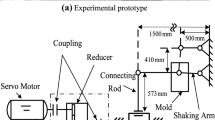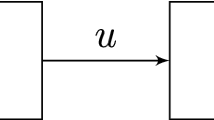Abstract
In view of the fact that the vibration displacement system of continuous casting mold driven by a servo motor requires the motor rotate in a certain fixed direction, a compound control scheme combining feedforward and feedback control is proposed in this paper. In controller designing, there are mainly two issues to be considered: i) constraint condition that the servo motor rotates in a fixed direction while the mold vibrates in a periodic form. ii) uncertainties caused by time-varying load and mechanical factors, such as mechanical zero initial deviation and machining precision. As to the system uncertainties and the periodic vibration displacement of mold, proportional-integral (PI) controller combined with the repetitive control method are used to realize displacement tracking and improve the tracking performance. A feedforward control algorithm consisting of the reference mold displacement and its first derivative is adopted to solve the constraint condition. Finally, some simulation results show the feasibility of the proposed algorithm for the constraint condition and system uncertainties. Additionally, a typical industry mold vibration system driven by a servo motor is conducted to show the effectiveness of the proposed control scheme.
Similar content being viewed by others
Abbreviations
- K q(s):
-
Transfer function of low-pass filter
- K b(s):
-
Transfer function of phase lead compensator
- G(s):
-
Transfer function of PI controller
- G RC(s):
-
Transfer function of repetitive controller (RC)
- S 0(s):
-
Sensitivity function of system without RC
- M s :
-
Maximum magnitude of S0(s)
- θr :
-
Rotation angle of eccentric shaft
- ω r :
-
Angular velocity of eccentric shaft
References
X. K. Li, L. P. Zhang, L. D. Yang, and Y. F. Yao, “Dynamics study on new non-sinusoidal oscillation system of mold,” Proc. of the 4th International Conf. on Continuous Casting of Steel, pp. 517–522, 2008.
X. N. Meng and M. Y. Zhu, “Optimization of nonsinusoidal oscillation parameters for slab continuous casting mould with high casting speed,” Ironmaking & Steel-making, vol. 36, no. 4, pp. 300–310, July 2009.
X. Z. Zhang, X. R. Zheng, Q. G. Liu, X. K. Li, and Y. M. Fang, “Investigation and application of non-sinusoidal oscillation technique of mold,” Journal of iron and steel research, international, vol. 20, no. 12, pp. 19–24, December 2013.
L. Liu, Y. Dun, Y. M. Fang, and G. Li, “Modeling and verification of the nonlinear system of oscillation platform of continuous casting mold driven by servo motor,” Advances in Mechanical Engineering, vol. 8, no. 7, pp. 1–9, July 2016.
Y. M. Fang, G. Li, J. X. Li, and L. Liu, “Modeling and analysing for oscillation system of continuous casting mold driven by servo motor,” Chinese Journal of Scientific Instrument, vol. 35, no. 11, pp. 2615–2623, November 2014.
S. H. Zhou, M. Xiao, and J. C. Song, “Modeling and control of electro-hydraulic-controlled stepping cylinder for mold oscillation,” Electrical Power Systems and Computers, vol. 99, pp. 183–189, 2011.
S. H. Kim, M. Seo, J. Ban, and N. W. Kong, “Mold oscillation feedforward control algorithm for sinusoidal oscillation of various asymmetries,” ISIJ, International, vol. 57, no. 11, pp. 2016–2021, November 2017.
C. Zhou, X. Z. Zhang, F. Wang, P. F. Liu, and Y. M. Fang, “Mechanism analysis of non-sinusoidal oscillation of continuous casting mold synchronously driven by double servo motors,” Journal of Iron and Steel Research, International, vol. 21, no. 3, pp. 251–257, March 2017.
T. Xia, K. S. Kang, Y. M. Fang, and L. Liu, “Nonlinear processing and control for the oscillation displacement system of continuous casting mold driven by servo motor,” Proc. of the 34th Chinese Control Conference, pp. 4443–4448, 2015.
H. C. Zheng, L. Liu, Y. M. Fang, and Q. Li, “Nonlinear auto disturbance rejection control for vibration displacement system of continuous cast mold driven by servo motor,” Proc. of the 35th Chinese Control Conference, pp.879–884, 2016.
Z. Ma, Y. M. Fang, H. C. Zheng, and L. Liu, “Active disturbance rejection control with self-adjusting parameters for vibration displacement system of continuous casting mold,” IEEE Access, vol. 7, pp. 52498–52507, April 2019.
K. S. Kang, L. Liu, Y. M. Fang, and H. C. Zheng, “Back-stepping sliding mode control for continuous cast mold oscillation displacement system driven by servo motor,” Control Theory & Applications, vol. 33, no. 11, pp. 1442–1448, November 2016.
S. L. Shi, K. S. Kang, J. X. Li, and Y. M. Fang, “Sliding Mode Control for Continuous Casting Mold Oscillatory System Driven by Servo Motor,” International Journal of Control Automation & Systems, vol. 15, no. 4, pp. 1669–1674, August 2016.
L. Liu, Z. Li, Y. M. Fang, and J. X. Li, “Sliding-mode control of continuous cast mold oscillation displacement system driven by servo motor,” Electric Machines and Control, vol. 20, no. 12, pp. 101–118, December 2016.
H. Chen and N. Sun, “Nonlinear control of underactuated systems subject to both actuated and unactuated state constraints with experimental verification,” IEEE Transactions on Industrial Electronics, vol. 67, no. 9, pp. 7702–7714, 2020.
H. Chen, B. Xuan, P. Yang, and H. Chen, “A new overhead crane emergency braking method with theoretical analysis and experimental verification,” Nonlinear Dynamics, vol. 98, no. 3, pp. 2211–2225, March 2019.
A. Rahimi, F. Bavafa, S. Aghababaei, M. H. Khooban, and S. V. Naghavi, “The online parameter identification of chaotic behaviour in permanent magnet synchronous motor by self-adaptive learning bat-inspired algorithm,” International Journal of Electrical Power & Energy Systems, vol. 78, pp. 285–291, June 2016.
M. R. Soltanpour, M. H. Khooban, and T. Niknam, “A robust and new simple control strategy for a class of nonlinear power systems: induction and servo motors,” Journal of Vibration and Control, vol. 22, no. 6, pp. 1568–1592, April 2016.
S. Zhang, W. Y. Cui, and E. A. Fuad, “Adaptive backstepping control design for uncertain non-smooth strict feedback nonlinear systems with time-varying delays,” International Journal of Control Automation & Systems, vol. 17, no. 9, pp. 2220–2233, September 2019.
S. F. Wu and J. W. Zhang, “A terminal sliding mode observer based robust backstepping sensorless speed control for interior permanent magnet synchronous motor,” International Journal of Control Automation & Systems, vol. 16, no. 6, pp. 2743–2753, December 2018.
M. H. Khooban, O. N. Almasi, and T. Niknam, “Intelligent robust PI adaptive control strategy for speed control of EV (s),” IET Science, Measurement & Technology, vol. 10, no. 5, pp. 433–441, August 2016.
M. H. Khooban, “Hardware-in-the-loop simulation for the analyzing of smart speed control in highly nonlinear hybrid electric vehicle,” Transactions of the Institute of Measurement and Control, vol. 41, no. 2, pp. 458–467, January 2019.
M. H. Khooban, T. Niknam, and M. S. Sadeghi, “Speed control of electrical vehicles: a time-varying proportionalintegral controller-based type-2 fuzzy logic,” IET Science, Measurement & Technology, vol. 10, no. 3, pp. 185–192, May 2016.
M. H. Khooban, M. Gheisarnejad, N. Vafamand, and J. Boudjadar, “Electric vehicle power propulsion system control based on time-varying fractional calculus: Implementation and experimental results,” IEEE Transactions on Intelligent Vehicles, vol. 4, no. 2, pp. 255–264, June 2019.
M. H. Khooban, M. S. Sadeghi, T. Niknam, and F. Blaabjerg, “Analysis, control and design of speed control of electric vehicles delayed model: multi-objective fuzzy fractional-order PIλDμ controller,” IET Science, Measurement & Technology, vol. 11, no. 3, pp. 249–261, November 2016.
M. Abusara, A. Sharkh, and P. Zanchetta, “Adaptive repetitive control with feedforward scheme for grid-connected inverters,” IET Power Electronics, vol. 8, no. 8, pp. 1403–1410, August 2015.
P. Mattavelli, L. Tubiana, and M. Zigliotto, “Torque ripple reduction in PM synchronous motor drives using repetitive current control,” IEEE Transaction on power electronics, vol. 20, no. 6, pp. 1423–1431, June 2005.
M. C. Tsai and W. S. Yao, “Design of a plug-in type repetitive controller for periodic inputs,” IEEE Transaction on Control Systems Technology, vol. 10, no. 4, pp. 547–555, July 2002.
M. Wu, B. Xu, W. Cao, and J. She, “Aperiodic disturbance rejection in repetitive-control systems,” IEEE Transaction on Control Systems Technology, vol. 22, no. 3, pp. 1044–1051, March 2014.
X. Li and D. Zhang, The Technique of the Mold Oscillation in Continuous Casting, Metallurgical Industry Press, Bejing, 2000.
Author information
Authors and Affiliations
Corresponding author
Additional information
Publisher’s Note Springer Nature remains neutral with regard to jurisdictional claims in published maps and institutional affiliations.
Recommended by Associate Editor Ning Sun under the direction of Editor Young IL Lee. This work was supported by the National Natural Science Foundation of China (No. 61873226), the National Science Foundation of Hebei Province(No. F2017203304, F2019203090), the Talent Project Training Funds of Hebei Province (No. A2016015002).
Qiang Li received his B.S. degree in control science and engineering from Yanshan University, China in 2005, where he is currently pursuing a Ph.D. degree. His research interests include nonlinear control, adaptive control, and system identification.
Yi-ming Fang received his B.S. and Ph.D. degrees in control science and engineering from Yanshan University, China, in 1985 and 2003, respectively. He is currently a professor with the School of Electrical Engineering, Yanshan University. His research interests include automation technology and application of continuous casting and steel rolling, modeling and controlling of complex system, adaptive robust control theory and application.
Jian-xiong Li received his B.S. and Ph.D. degrees in control science and engineering from Yanshan University, in 2004 and 2012, respectively. He is currently an associate professor with the School of Electrical Engineering, Yanshan University. His research interests include robust adaptive control theory with applications to electrohydraulic servo motor system.
Wen-jian Zhang received his B.S. degree in control science and engineering from Tiangong University, China in 2017. His research interests include robust adaptive control theory.
Rights and permissions
About this article
Cite this article
Li, Q., Fang, Ym., Li, Jx. et al. Feedforward and Feedback Compound Control of Vibration Displacement for a Continuous Casting Mold Driven by a Servo Motor. Int. J. Control Autom. Syst. 18, 3218–3228 (2020). https://doi.org/10.1007/s12555-019-0998-0
Received:
Revised:
Accepted:
Published:
Issue Date:
DOI: https://doi.org/10.1007/s12555-019-0998-0




